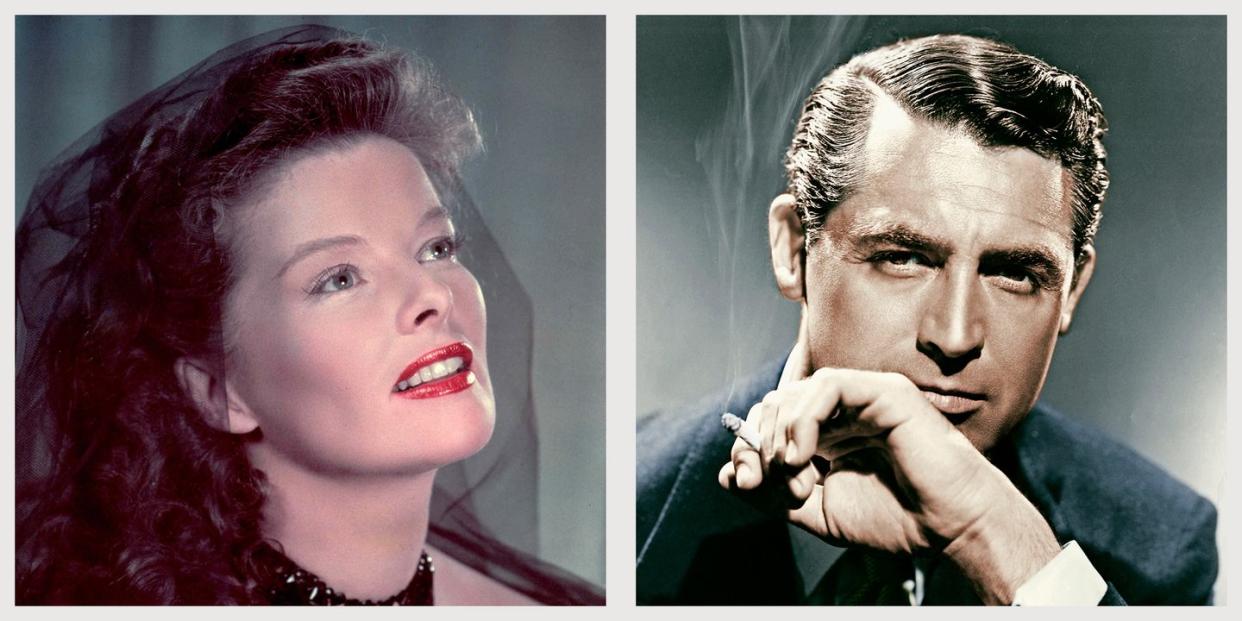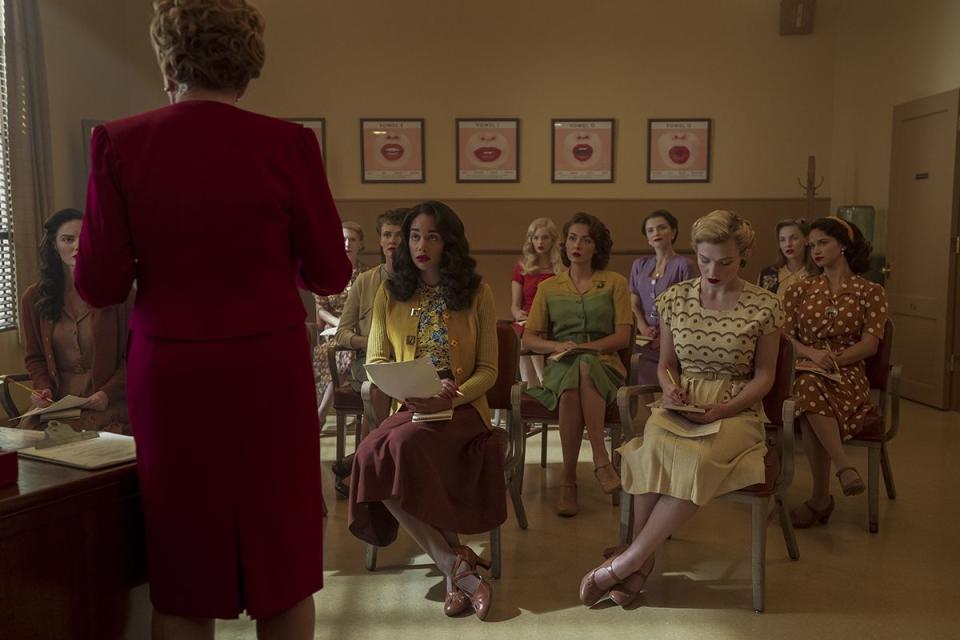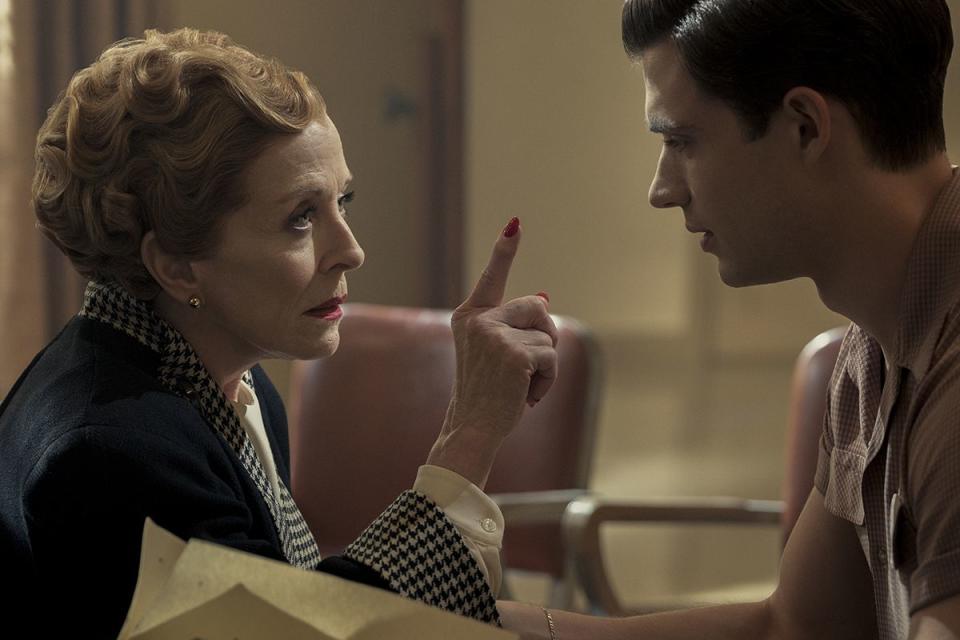How the Golden Age of Hollywood Tried to Make Everyone Sound Filthy Rich

"The rain in Spain stays mainly in the plain." If ever there was a phrase that embodied the idea of changing one’s accent to get ahead, that’d be it. After all, the My Fair Lady song that the lyric comes from is meant to showcase how a Cockney flower girl can advance her social standing simply by improving her diction. And Eliza Doolittle wasn’t the only one giving it a shot.
Throughout the Golden Age of Hollywood, stars including Katherine Hepburn, Cary Grant, Bette Davis, and Orson Welles employed what’s known as a “Mid-Atlantic accent,” a sort of American-British hybrid of speaking that relies on tricks like dropping “R” sounds and softening vowels, in order to convey wealth and sophistication on the silver screen.
It’s a trick that fell out of favor by the middle of the 20th century but still pops up in popular culture—cheerio, Madonna!—and is on full display in Hollywood, the new Netflix series produced by Ryan Murphy.

In the second episode of the series, a group of aspiring young actresses are seated in a classroom at the fictional Ace Studios being tutored in the art of using the mid-Atlantic accent properly. “Mid-Atlantic is a made-up accent; no one actually speaks this way naturally,” Holland Taylor’s Ellen Kincaid, a studio casting executive charged with training young talent, tells the group of wishful starlets. “But it takes on some British inflections that add some refinement to the otherwise flat and grating American dialect. You ladies would do very well to speak in this dialect at all times.”
In the scene, Kincaid asks one student “where does the Mid-Atlantic accent come from?” “The middle of the Atlantic,” she answers. “And who lives there?” Another student pipes up: “No one.”
It’s a short scene but an important one for the series to get right. “In 1947, the year we begin in, more movies were made than ever before; the demand was so enormous that all of these studios were constantly pumping films out. They needed bodies, so we knew that this sort of training center within a studio would be an access point,” says Hollywood producer Ian Brennan.
“And if you’re going to be in those rooms, it seemed like the natural thing to do was see a group of starlets sitting around trying to learn the Mid-Atlantic accent, which they really did. If you listen to those old movies, people spoke in a way that sounds so funny today. So, we wanted to go behind the scenes of that kind of scenario. It seemed like the obvious first place to go to transport people into this world.”

The Mid-Atlantic accent was important to include in the series, Brennan says, because “it denotes a kind of upper crust, East Coast wealth—but it’s an affectation. It was created to unify and standardize an American dialect; people thought that American English could be harsh and flat, so this was almost halfway British. It was a way to add a patina of class and élan to speech that would otherwise sound provincial.”
The accent’s beginnings aren’t entirely clear. Some experts trace it back to early American prep school oration classes, the work of the 19th-century philologist Henry Sweet, or that of the Australian linguist William Tilly, a former student of Sweet’s who went on to teach at Columbia University. Most can agree, however, that it was voice coach Edith Skinner (a former Tilly associate) who really made the Mid-Atlantic accent popular.
In 1942, Skinner—who taught at Juilliard and Carnegie Mellon—published Speak with Distinction, which became the de facto diction bible for anyone looking to speak in what Skinner called “Good Speech.”
The book, which is still available today, gave advise on how to hold your lips and where to position your tongue, and recommendations on exercises for the jaw, neck, and shoulders to aid in proper pronunciation. “Distinct utterance is the prime requisite of an actor,” Skinner wrote. “In fact, the audience should be able to take for granted that they can hear and understand everything the actor says, without straining to do so.”
When it came to how she wanted her pupils to sound, Skinner wrote, “Good Speech is hard to define but easy to recognize when we hear it. Good Speech is a dialect of North American English that is free from regional characteristics; recognizably North American, yet suitable for classic texts; effortlessly articulated and easily understood in the last rows of a theater.”
It was a technique that dovetailed with the rise of “talkies,” which first came about in 1927, and gave actors the opportunity to use their voices to help further a story. “The real secret of it, in terms of what Hollywood was packaging, was that you could find yourself upwardly mobile by only changing the sound of your voice,” explains Samara Bay, a dialect coach who’s worked on American Crime Story and I Am the Night. “What a deeply American mythos to be able to do that: It’s the vocal equivalent of bootstrapping.”
Despite its popularity at the time—making it a touchstone in movies like His Girl Friday, The Philadelphia Story, and Citizen Kane—the accent would fall out of fashion after World War II. Later, figures like Gore Vidal and William F. Buckley would continue to use the accent to punctuate their public speaking and it would show up as a punchline most often to mock snobs, like it did in the TV series Frasier—but today the use of the Mid-Atlantic accent on screen (with the exception of Cate Blanchett using a similar version in Mrs. America to what she did in The Talented Mister Ripley) has all but disappeared.
Still, while you might not hear the Mid-Atlantic accent regularly in modern movies, its legacy hasn’t vanished entirely. “What is left over is a sense that there’s a right way to sound, and you’re in the club or you’re not,” Bay says. “In any culture, there is a sound that’s associated with power—and it’s usually the sound associated with the richest, oldest, and whitest people in that culture. Then it’s up to everyone else to decide, do I want to match that or deviate from it and stand strong on my own?”
It’s an idea that isn’t lost on the creators of Hollywood. “That’s the theme of the show,” says Brennan. “Why are we trying to fit into a system that doesn’t want to include us instead of trying to create a new system? Hollywood isn’t only exciting because you get to bathe in nostalgia and the lushness of the period, but also because it makes a broader and quite pointed statement about inclusion and aspiration. Is this the best we can do, or might there be something more?”
You Might Also Like

